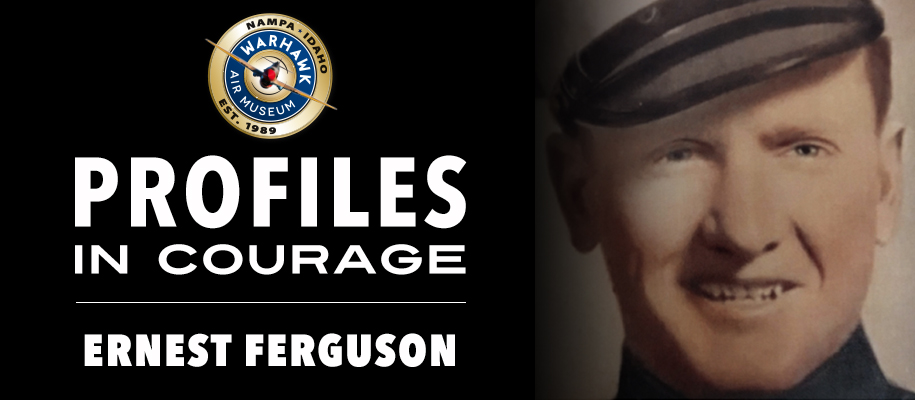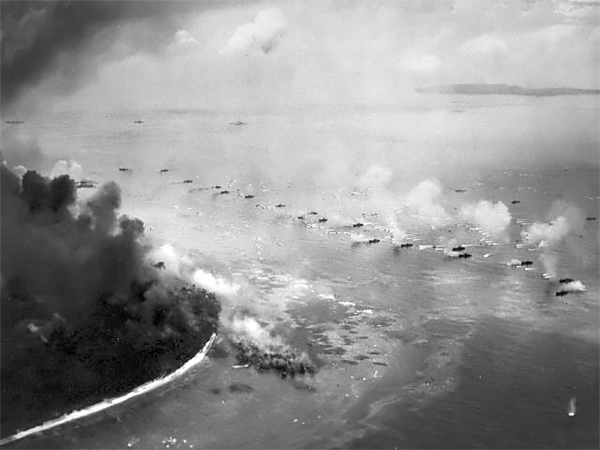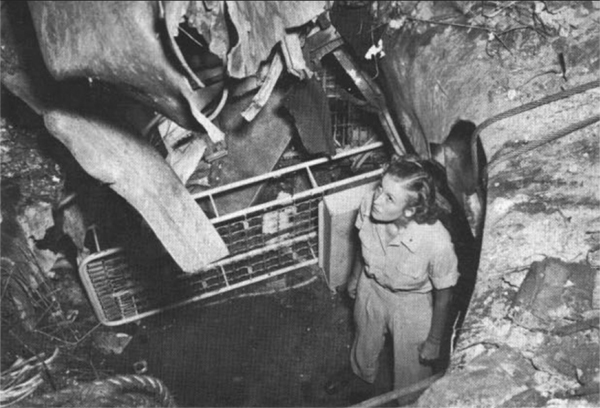
Posted On: November 17, 2023
“We had a saying in the Marine Corps. ‘Ours is not the reason why. Ours is but to do or die.’ So you wasn’t sure of anything. Most of the men were prepared. I come back to Peleliu because I want to pay my respects to those that didn’t make it.”
– Sgt. Ernest Ferguson, 2020
Once a Marine
On the first Tuesday of every month, the Warhawk Air Museum hosts the Kilroy Coffee Klatch. Veterans from World War II, Korea, Vietnam, the Gulf War, Desert Shield/Storm, and the Global War on Terror come to the museum to drink coffee, eat delicious breakfast treats, listen to keynote speakers, and surround themselves with the few people who truly understand what they’ve gone through. Amongst the sea of veterans sits a man wearing a black cowboy hat, pride of being a Marine in his eyes. Next to him are the two crutches he has been walking with since 1945. His name is Ernest Ferguson, but we call him Ernie. During World War II, he was Sergeant Ernest Ferguson of the United States Marine Corps assigned to the 1st Marine Division, Company B, 1st Battalion, 5th Regiment.
Ernie is from a small town in California and one of 13 children. When high school began, he witnessed images and news from World War II as they began flashing at his town’s movie theater, including an announcement of the attack on Pearl Harbor on December 7, 1941. Ernie began to wonder what would happen should the U.S. be invaded. What would happen to his family? He realized it was time to step into action and went off to the recruiting station. However, Ernie forgot to lie about his age; he was only 16 and too young to join. When he was 18, the U.S. called Ernie up for service and Ernie answered. After walking through the doors for his physical, he joined the line marked by a “Marines” sign.
Battle of Peleliu: September 15, 1944

The first wave of LVTs moves toward the invasion beaches, passing through the inshore bombardment line of LCI gunboats on September 15, 1944. Cruisers and battleships are bombarding from the distance. The landing area is almost totally hidden in dust and smoke.
The Allies began to take back the Philippines one island at a time. Ernie was part of this mission. After claiming victory in the New Britain Campaign, Ernie and his fellow 5th Marine comrades landed on Peleliu beaches Orange 1 and Orange 2 on September 15, 1944. They were to take the airfield and then move northeast. With the tanks yet to arrive, the Marines pushed on, armed only with small firearms. Ernie and his team headed to the airfield for Operation Stalemate II, but there were over 10,000 Japanese troops armed and waiting. The Japanese used the island’s natural landscapes to build tunnels and bunkers within the mountains, concealing their positions while having eyes on the Marines.
On September 16, 1944, Ernie and his team reached the airfield. Ernie recalls that no one was around him as he walked across it. He was one of the first ones that had made it to the other side. One night, while Ernie was guarding an outpost, with a Doberman by his side (there were usually two men to an outpost and to a foxhole, but because of the loss of so many, there was currently only one to each) he could hear Japanese soldiers yelling through the darkness, “Marines you die!” The fear that he might die gripped him and, thinking back on that day, Ernie reflects, “It’s hard as a young man to realize you might not make it to the next morning.” He didn’t sleep for three days.
There was a close call when a mortar landed just five feet away from Ernie. It was a dud but that did not mean the danger had passed. If another mortar landed nearby, not only would it explode, but it could also trigger the other. Ernie raced to find safety down from hill he was on, joining with two other Marines. They rounded a corner and came face to face with the mouth of a .75 mm howitzer. Three Marines faced off with the howitzer…only two got away. Ernie and his remaining companion did not have bazookas or flame throwers, they could only call for more artillery mortar fire.
The conquering of Peleliu was only supposed to take a few days, but those days turned into two months. Not only did it take longer to conquer, but it also became the “highest casualty rate of any amphibious assault in American military history”1 with 40% percent of the 28,000 Marines and soldiers who fought on that island having either been wounded or killed. By November 1944, the Americans accomplished their mission, but not without paying the heaviest price.
Battle of Okinawa: April 1, 1945

A U.S. Army nurse surveys the damage aboard the U.S. Navy hospital ship USS Comfort following the kamikaze attack in April 1945. 28 were killed (including six nurses), and 48 wounded.
As the Allies continued closing in on Japan’s home islands, they made it to Okinawa. It was here that Ernie was shot in the back by a Japanese sergeant. He spent the next 14 months on a Navy hospital ship. While Ernie was recovering, he heard the USS Comfort—the hospital ship next to his—being targeted by a kamikaze suicide attack. While he recovered, Ernie has walked with two crutches since that injury.
Always a Marine
In 1945, the war was over and Ernie came home. He moved to Bakersfield, California where he worked in the oil fields He met the love of his life, Marie, and they had two sons, Dan and Bart. Dan served in Vietnam as a Huey pilot and Ernie was there to drop him off at the bus station to report for duty. For 75 years, Ernie tried to forget the horrors and trauma he faced while in the military. Then, he found the Warhawk Air Museum and began to tell his story. In February of 2020, Ernie went back to Peleliu. Once again he walked along the airstrip that he walked down in 1944. In 1944 he hadn’t seen anyone around him and didn’t look behind him thinking he was alone. Later, when he saw photos of the airstrip on that day, he learned that there had been other Marines with him. In 2020 though, Ernie was truly by himself.
As the Star-Spangled Banner is sung and the Pledge of Allegiance is said at the beginning of each Kilroy, among the many veterans that are present stands Ernie. He raises his right hand to salute the American flag every time. It has been over 75 years since the day he first stepped onto the beaches of Peleliu, but Ernie is still very clearly a U.S. Marine.
You can say hello to Ernie at our Kilroy Coffee Klatch and read his story about his time in service as well as the story of his return to Peleliu. His story is also available on YouTube in the video titled, “Sgt. Ernie Ferguson: 1st Marine Battle of Peleliu” produced, edited, and filmed by Zebadiah Baney. In an interview given during his return to Peleliu, Ernie stated:
“I pray that the Palauan government would make such a stiff penalty for anybody that tries to rob your freedom, that they wouldn’t want to chance it.”
The Warhawk Air Museum is honored to call Ernie a friend and we would like to wish him a very happy birthday as he will be turning 99 years old this November 2023.
Happy Birthday, Marine. Ooh-rah!
Resources:
- History.com Editors. (2009, November 18). Battle of Peleliu. History.com. https://www.history.com/topics/world-war-ii/battle-of-peleliu
- Zebadiah Baney. (2020). Sgt. Ernie Ferguson: 1st Marine Battle of Peleliu. YouTube. Retrieved September 13, 2023, from https://www.youtube.com/watch?v=5GeIOF_Akas.
- The Battle of Peleliu. Marine Corps University > Research > Marine Corps History Division > Brief Histories > Marines in World War II >. (n.d.-a). https://www.usmcu.edu/Research/Marine-Corps-History-Division/Brief-Histories/Marines-in-World-War-II/The-Battle-of-Peleliu/
- The New Britain Campaign. Marine Corps University > Research > Marine Corps History Division > Brief Histories > Marines in World War II >. (n.d.). https://www.usmcu.edu/Research/Marine-Corps-History-Division/Brief-Histories/Marines-in-World-War-II/The-New-Britain-Campaign/




Congratulations Ernie!
Thank you for your service… and YOUR LIFE!!!
Keep it going for another 99.